Comprehensive System Analysis Report: Unified Health Record System
VerifiedAdded on 2022/11/13
|15
|1745
|410
Report
AI Summary
This report presents a comprehensive system analysis of a unified health record management system. It begins by outlining the detailed functional and non-functional requirements of the system, emphasizing data security, user access control, and system performance. The analysis then delves into the system's architecture, component design, and data storage locations, illustrating these aspects with figures. Data flow diagrams, including context, level 0, and level 1 diagrams, are used to map the flow of information within the system. Use case diagrams are also provided to describe user interactions. Furthermore, the report includes a conceptual model and relational schema for the database design, detailing entities, attributes, and relationships. The report concludes with a bibliography of relevant sources supporting the analysis.

Running head: SYSTEM ANALYSIS
System Analysis
Name of the Student:
Name of the University:
Author Note
System Analysis
Name of the Student:
Name of the University:
Author Note
Paraphrase This Document
Need a fresh take? Get an instant paraphrase of this document with our AI Paraphraser
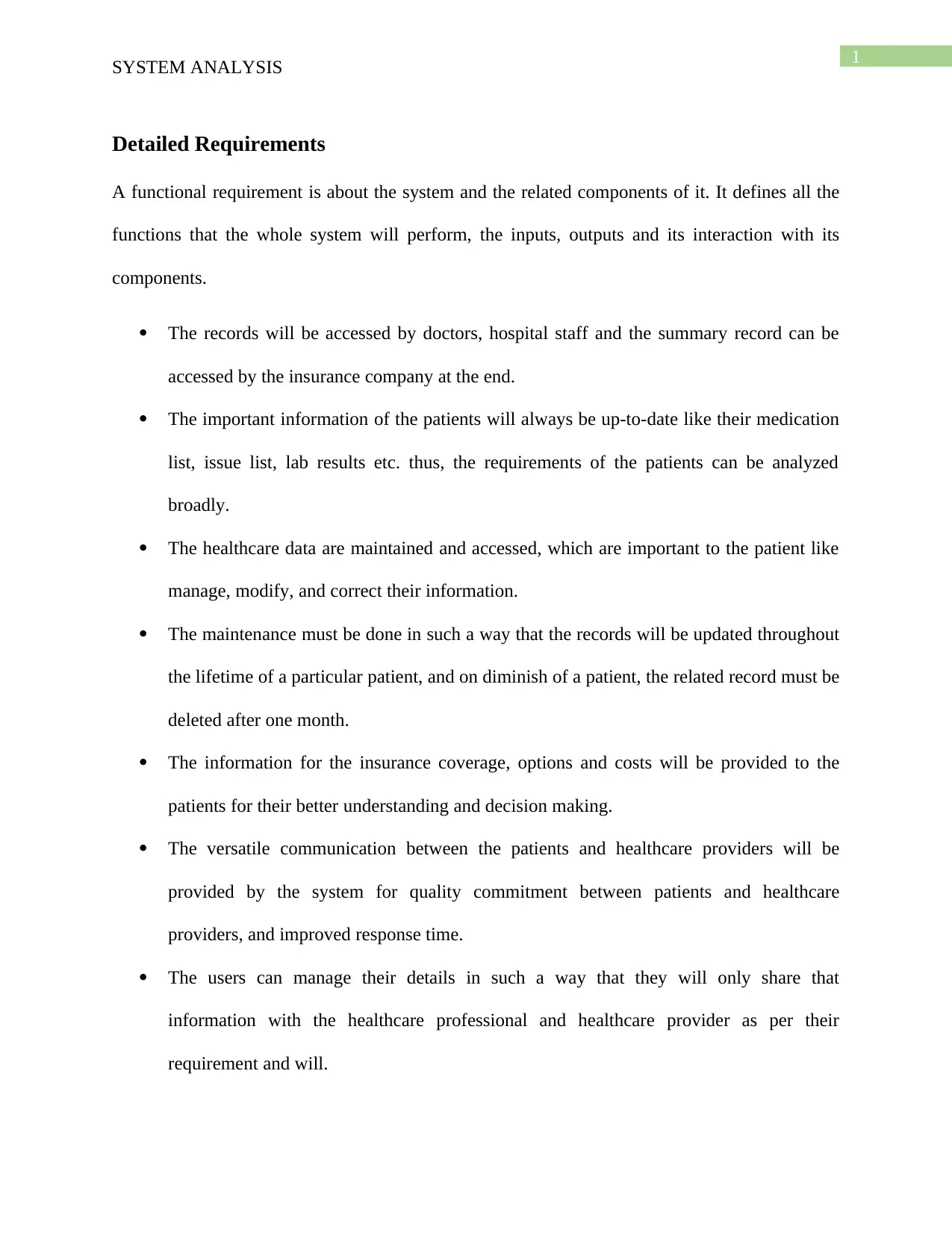
1
SYSTEM ANALYSIS
Detailed Requirements
A functional requirement is about the system and the related components of it. It defines all the
functions that the whole system will perform, the inputs, outputs and its interaction with its
components.
The records will be accessed by doctors, hospital staff and the summary record can be
accessed by the insurance company at the end.
The important information of the patients will always be up-to-date like their medication
list, issue list, lab results etc. thus, the requirements of the patients can be analyzed
broadly.
The healthcare data are maintained and accessed, which are important to the patient like
manage, modify, and correct their information.
The maintenance must be done in such a way that the records will be updated throughout
the lifetime of a particular patient, and on diminish of a patient, the related record must be
deleted after one month.
The information for the insurance coverage, options and costs will be provided to the
patients for their better understanding and decision making.
The versatile communication between the patients and healthcare providers will be
provided by the system for quality commitment between patients and healthcare
providers, and improved response time.
The users can manage their details in such a way that they will only share that
information with the healthcare professional and healthcare provider as per their
requirement and will.
SYSTEM ANALYSIS
Detailed Requirements
A functional requirement is about the system and the related components of it. It defines all the
functions that the whole system will perform, the inputs, outputs and its interaction with its
components.
The records will be accessed by doctors, hospital staff and the summary record can be
accessed by the insurance company at the end.
The important information of the patients will always be up-to-date like their medication
list, issue list, lab results etc. thus, the requirements of the patients can be analyzed
broadly.
The healthcare data are maintained and accessed, which are important to the patient like
manage, modify, and correct their information.
The maintenance must be done in such a way that the records will be updated throughout
the lifetime of a particular patient, and on diminish of a patient, the related record must be
deleted after one month.
The information for the insurance coverage, options and costs will be provided to the
patients for their better understanding and decision making.
The versatile communication between the patients and healthcare providers will be
provided by the system for quality commitment between patients and healthcare
providers, and improved response time.
The users can manage their details in such a way that they will only share that
information with the healthcare professional and healthcare provider as per their
requirement and will.
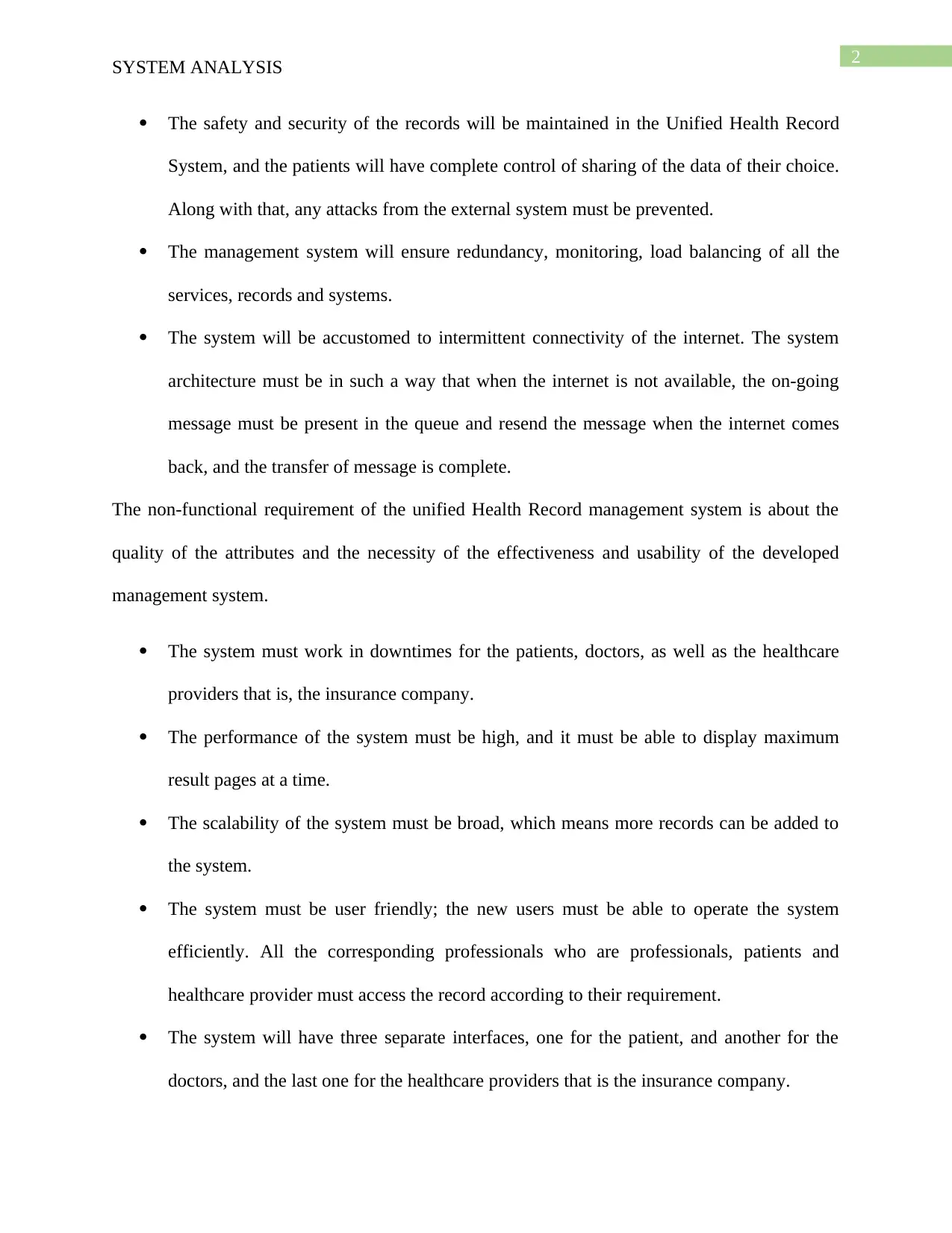
2
SYSTEM ANALYSIS
The safety and security of the records will be maintained in the Unified Health Record
System, and the patients will have complete control of sharing of the data of their choice.
Along with that, any attacks from the external system must be prevented.
The management system will ensure redundancy, monitoring, load balancing of all the
services, records and systems.
The system will be accustomed to intermittent connectivity of the internet. The system
architecture must be in such a way that when the internet is not available, the on-going
message must be present in the queue and resend the message when the internet comes
back, and the transfer of message is complete.
The non-functional requirement of the unified Health Record management system is about the
quality of the attributes and the necessity of the effectiveness and usability of the developed
management system.
The system must work in downtimes for the patients, doctors, as well as the healthcare
providers that is, the insurance company.
The performance of the system must be high, and it must be able to display maximum
result pages at a time.
The scalability of the system must be broad, which means more records can be added to
the system.
The system must be user friendly; the new users must be able to operate the system
efficiently. All the corresponding professionals who are professionals, patients and
healthcare provider must access the record according to their requirement.
The system will have three separate interfaces, one for the patient, and another for the
doctors, and the last one for the healthcare providers that is the insurance company.
SYSTEM ANALYSIS
The safety and security of the records will be maintained in the Unified Health Record
System, and the patients will have complete control of sharing of the data of their choice.
Along with that, any attacks from the external system must be prevented.
The management system will ensure redundancy, monitoring, load balancing of all the
services, records and systems.
The system will be accustomed to intermittent connectivity of the internet. The system
architecture must be in such a way that when the internet is not available, the on-going
message must be present in the queue and resend the message when the internet comes
back, and the transfer of message is complete.
The non-functional requirement of the unified Health Record management system is about the
quality of the attributes and the necessity of the effectiveness and usability of the developed
management system.
The system must work in downtimes for the patients, doctors, as well as the healthcare
providers that is, the insurance company.
The performance of the system must be high, and it must be able to display maximum
result pages at a time.
The scalability of the system must be broad, which means more records can be added to
the system.
The system must be user friendly; the new users must be able to operate the system
efficiently. All the corresponding professionals who are professionals, patients and
healthcare provider must access the record according to their requirement.
The system will have three separate interfaces, one for the patient, and another for the
doctors, and the last one for the healthcare providers that is the insurance company.
⊘ This is a preview!⊘
Do you want full access?
Subscribe today to unlock all pages.

Trusted by 1+ million students worldwide
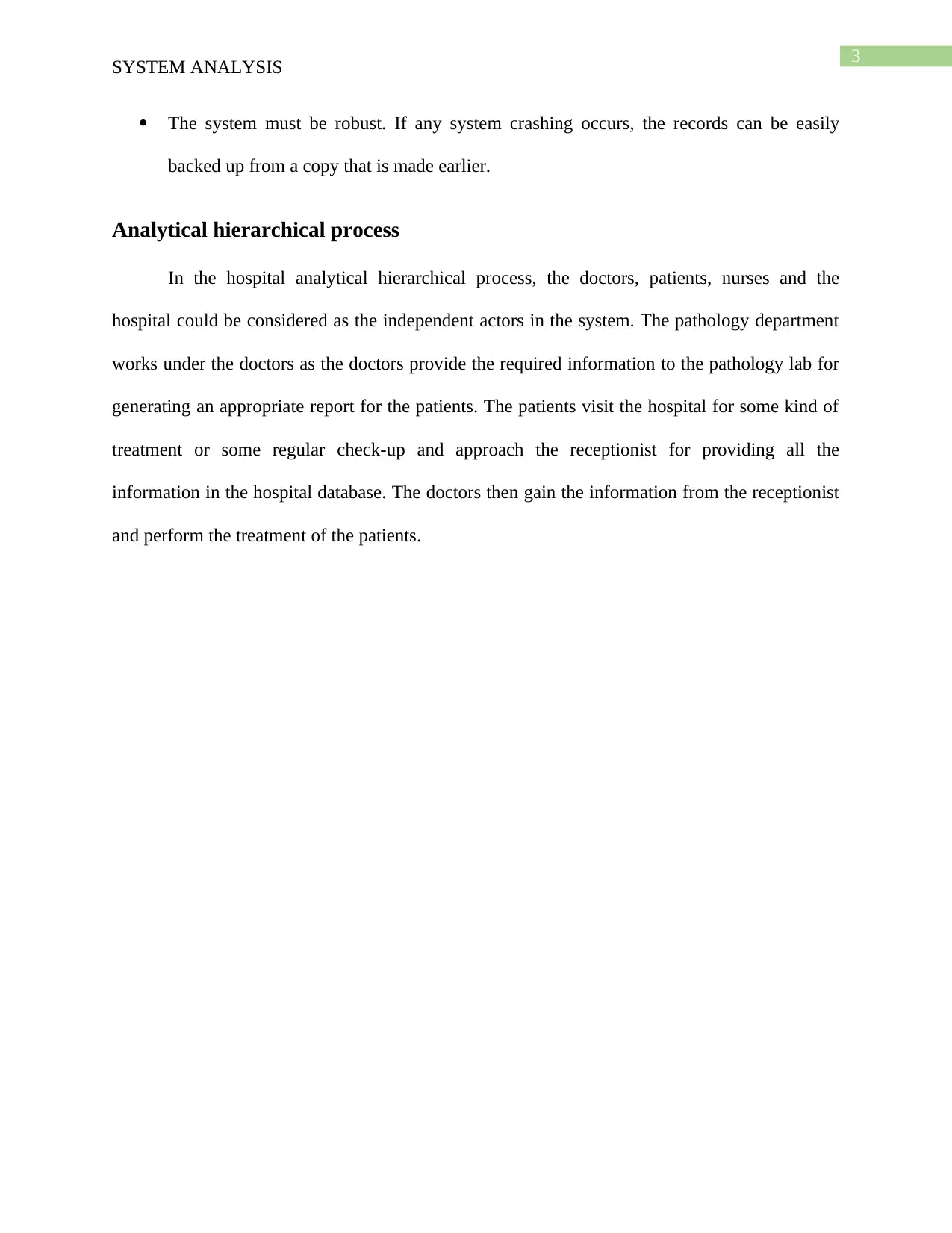
3
SYSTEM ANALYSIS
The system must be robust. If any system crashing occurs, the records can be easily
backed up from a copy that is made earlier.
Analytical hierarchical process
In the hospital analytical hierarchical process, the doctors, patients, nurses and the
hospital could be considered as the independent actors in the system. The pathology department
works under the doctors as the doctors provide the required information to the pathology lab for
generating an appropriate report for the patients. The patients visit the hospital for some kind of
treatment or some regular check-up and approach the receptionist for providing all the
information in the hospital database. The doctors then gain the information from the receptionist
and perform the treatment of the patients.
SYSTEM ANALYSIS
The system must be robust. If any system crashing occurs, the records can be easily
backed up from a copy that is made earlier.
Analytical hierarchical process
In the hospital analytical hierarchical process, the doctors, patients, nurses and the
hospital could be considered as the independent actors in the system. The pathology department
works under the doctors as the doctors provide the required information to the pathology lab for
generating an appropriate report for the patients. The patients visit the hospital for some kind of
treatment or some regular check-up and approach the receptionist for providing all the
information in the hospital database. The doctors then gain the information from the receptionist
and perform the treatment of the patients.
Paraphrase This Document
Need a fresh take? Get an instant paraphrase of this document with our AI Paraphraser
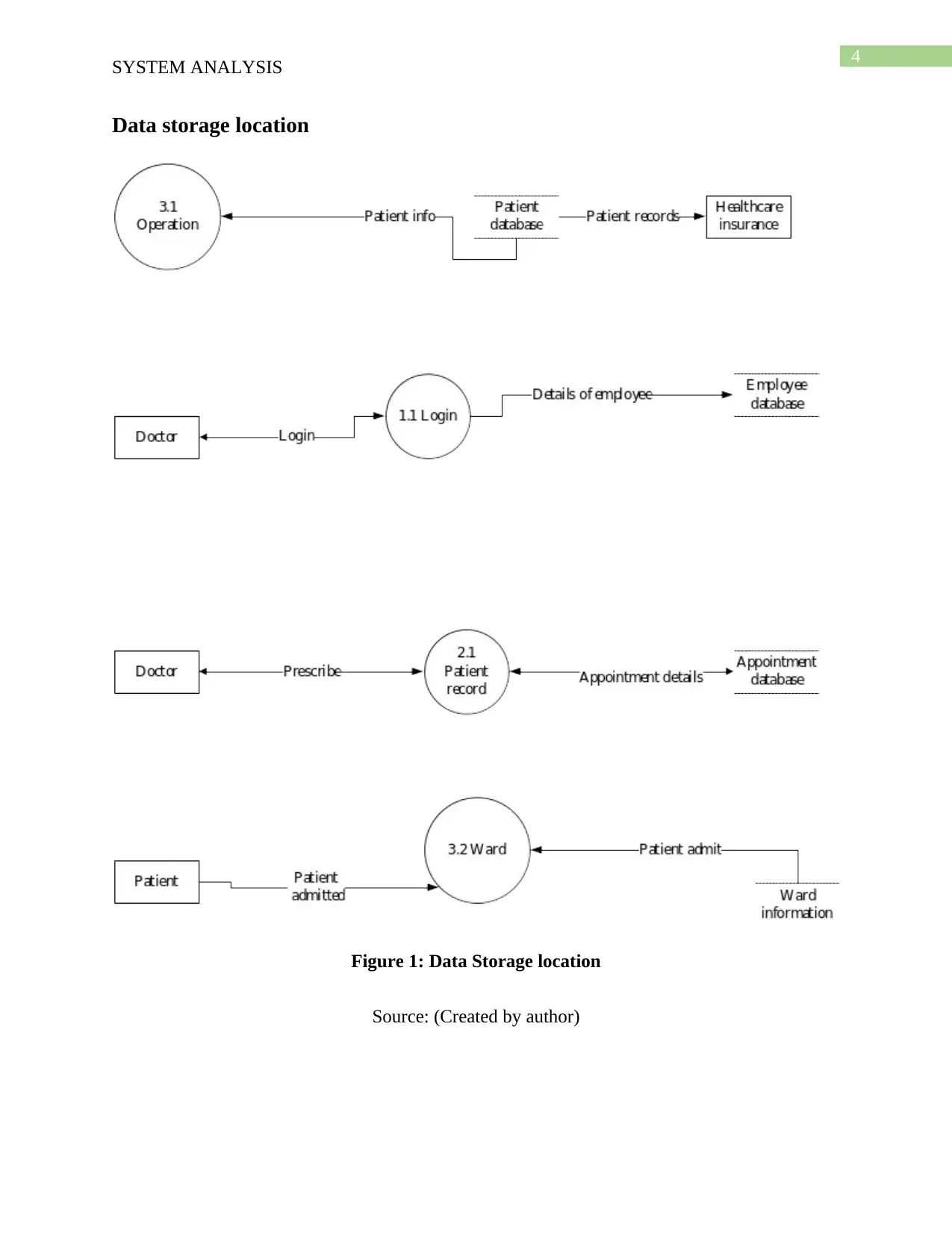
4
SYSTEM ANALYSIS
Data storage location
Figure 1: Data Storage location
Source: (Created by author)
SYSTEM ANALYSIS
Data storage location
Figure 1: Data Storage location
Source: (Created by author)
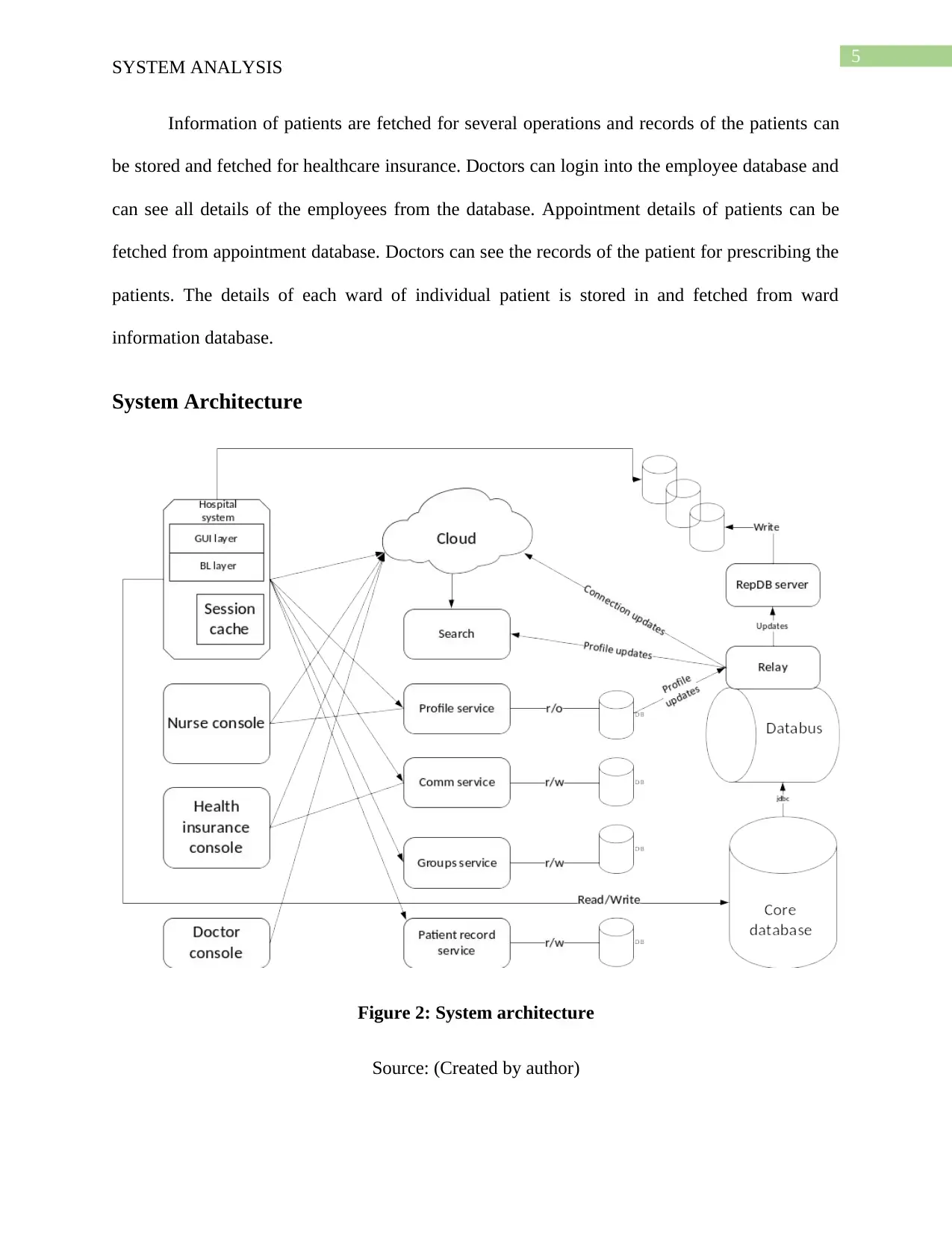
5
SYSTEM ANALYSIS
Information of patients are fetched for several operations and records of the patients can
be stored and fetched for healthcare insurance. Doctors can login into the employee database and
can see all details of the employees from the database. Appointment details of patients can be
fetched from appointment database. Doctors can see the records of the patient for prescribing the
patients. The details of each ward of individual patient is stored in and fetched from ward
information database.
System Architecture
Figure 2: System architecture
Source: (Created by author)
SYSTEM ANALYSIS
Information of patients are fetched for several operations and records of the patients can
be stored and fetched for healthcare insurance. Doctors can login into the employee database and
can see all details of the employees from the database. Appointment details of patients can be
fetched from appointment database. Doctors can see the records of the patient for prescribing the
patients. The details of each ward of individual patient is stored in and fetched from ward
information database.
System Architecture
Figure 2: System architecture
Source: (Created by author)
⊘ This is a preview!⊘
Do you want full access?
Subscribe today to unlock all pages.

Trusted by 1+ million students worldwide
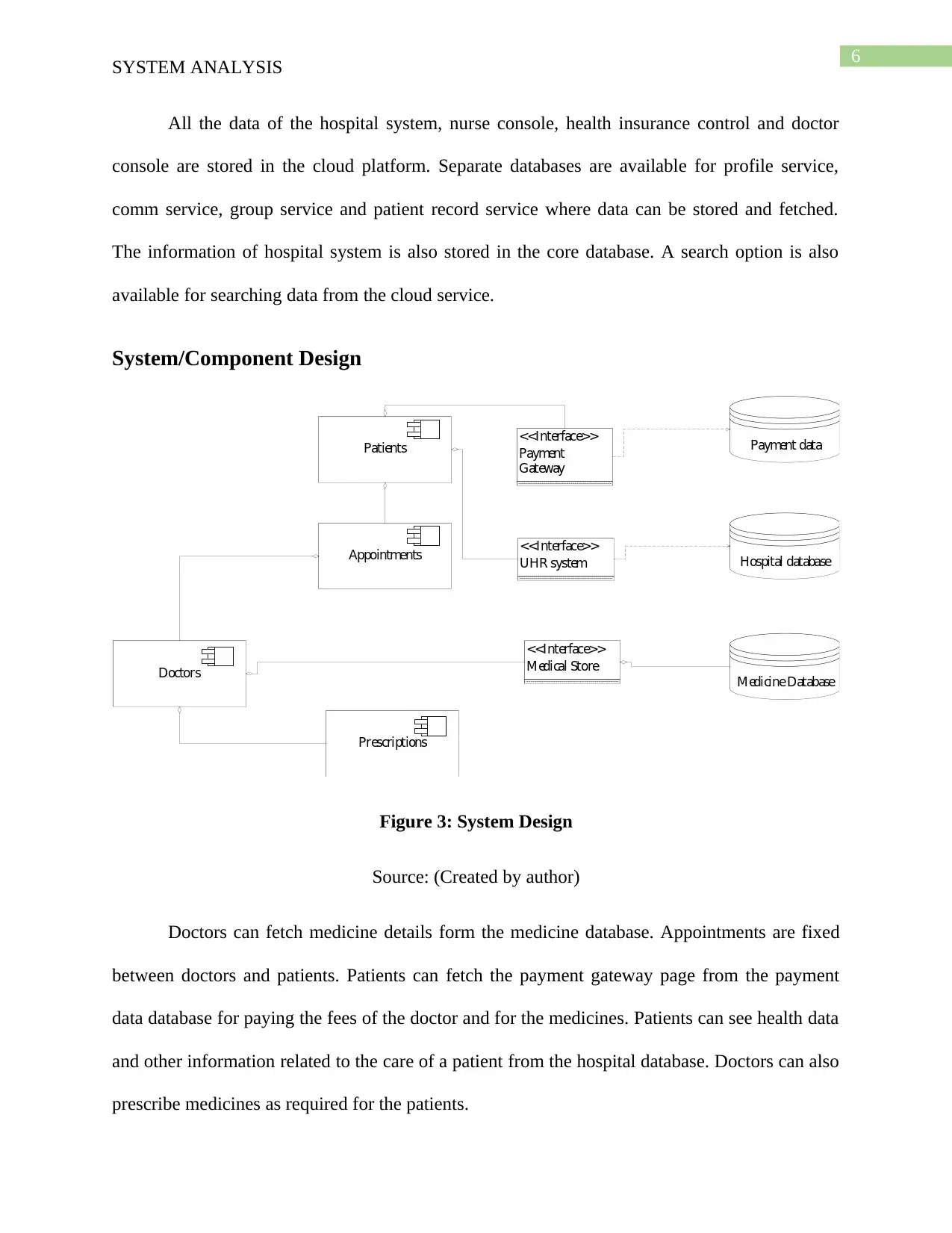
6
SYSTEM ANALYSIS
All the data of the hospital system, nurse console, health insurance control and doctor
console are stored in the cloud platform. Separate databases are available for profile service,
comm service, group service and patient record service where data can be stored and fetched.
The information of hospital system is also stored in the core database. A search option is also
available for searching data from the cloud service.
System/Component Design
Figure 3: System Design
Source: (Created by author)
Doctors can fetch medicine details form the medicine database. Appointments are fixed
between doctors and patients. Patients can fetch the payment gateway page from the payment
data database for paying the fees of the doctor and for the medicines. Patients can see health data
and other information related to the care of a patient from the hospital database. Doctors can also
prescribe medicines as required for the patients.
SYSTEM ANALYSIS
All the data of the hospital system, nurse console, health insurance control and doctor
console are stored in the cloud platform. Separate databases are available for profile service,
comm service, group service and patient record service where data can be stored and fetched.
The information of hospital system is also stored in the core database. A search option is also
available for searching data from the cloud service.
System/Component Design
Figure 3: System Design
Source: (Created by author)
Doctors can fetch medicine details form the medicine database. Appointments are fixed
between doctors and patients. Patients can fetch the payment gateway page from the payment
data database for paying the fees of the doctor and for the medicines. Patients can see health data
and other information related to the care of a patient from the hospital database. Doctors can also
prescribe medicines as required for the patients.
Paraphrase This Document
Need a fresh take? Get an instant paraphrase of this document with our AI Paraphraser
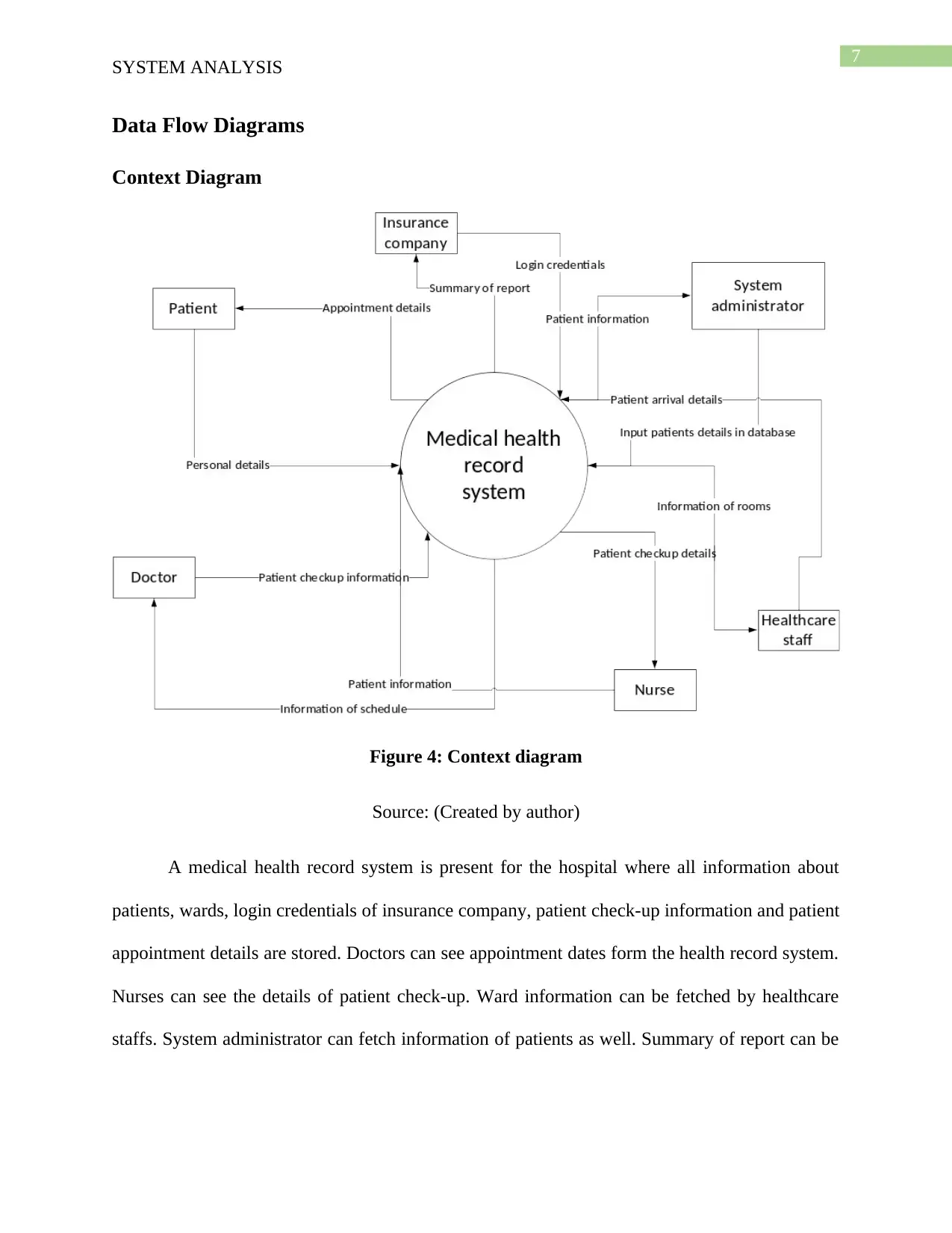
7
SYSTEM ANALYSIS
Data Flow Diagrams
Context Diagram
Figure 4: Context diagram
Source: (Created by author)
A medical health record system is present for the hospital where all information about
patients, wards, login credentials of insurance company, patient check-up information and patient
appointment details are stored. Doctors can see appointment dates form the health record system.
Nurses can see the details of patient check-up. Ward information can be fetched by healthcare
staffs. System administrator can fetch information of patients as well. Summary of report can be
SYSTEM ANALYSIS
Data Flow Diagrams
Context Diagram
Figure 4: Context diagram
Source: (Created by author)
A medical health record system is present for the hospital where all information about
patients, wards, login credentials of insurance company, patient check-up information and patient
appointment details are stored. Doctors can see appointment dates form the health record system.
Nurses can see the details of patient check-up. Ward information can be fetched by healthcare
staffs. System administrator can fetch information of patients as well. Summary of report can be
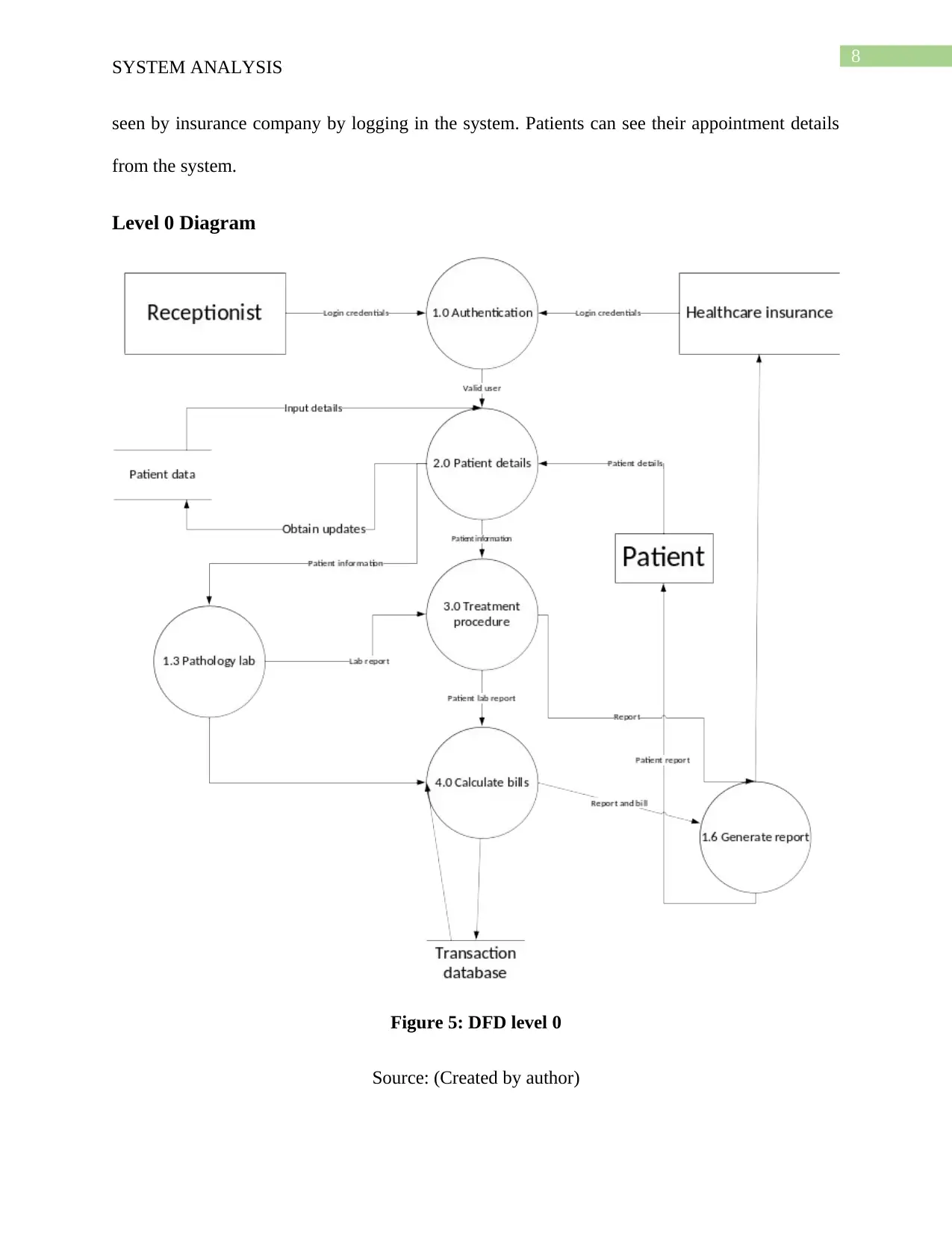
8
SYSTEM ANALYSIS
seen by insurance company by logging in the system. Patients can see their appointment details
from the system.
Level 0 Diagram
Figure 5: DFD level 0
Source: (Created by author)
SYSTEM ANALYSIS
seen by insurance company by logging in the system. Patients can see their appointment details
from the system.
Level 0 Diagram
Figure 5: DFD level 0
Source: (Created by author)
⊘ This is a preview!⊘
Do you want full access?
Subscribe today to unlock all pages.

Trusted by 1+ million students worldwide
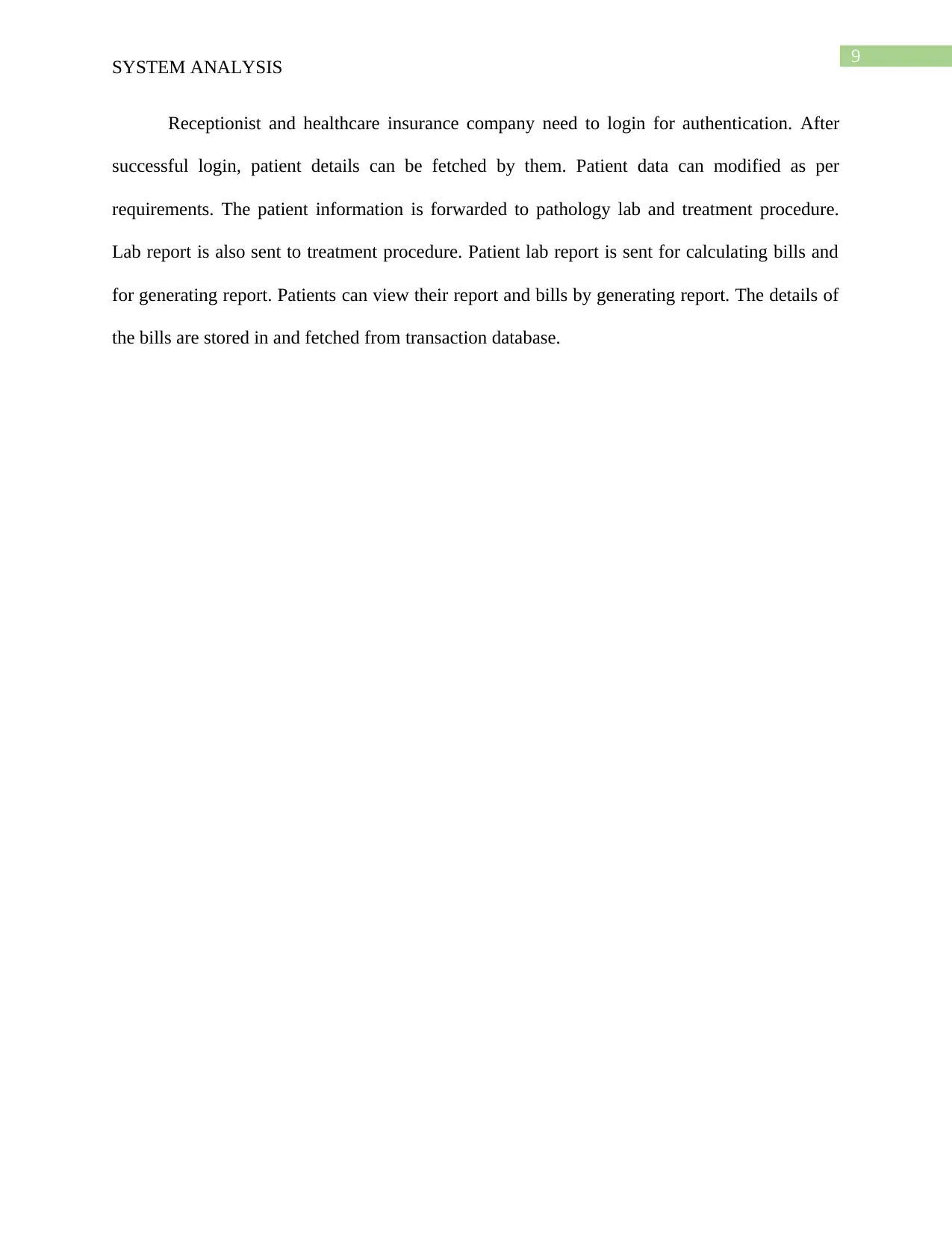
9
SYSTEM ANALYSIS
Receptionist and healthcare insurance company need to login for authentication. After
successful login, patient details can be fetched by them. Patient data can modified as per
requirements. The patient information is forwarded to pathology lab and treatment procedure.
Lab report is also sent to treatment procedure. Patient lab report is sent for calculating bills and
for generating report. Patients can view their report and bills by generating report. The details of
the bills are stored in and fetched from transaction database.
SYSTEM ANALYSIS
Receptionist and healthcare insurance company need to login for authentication. After
successful login, patient details can be fetched by them. Patient data can modified as per
requirements. The patient information is forwarded to pathology lab and treatment procedure.
Lab report is also sent to treatment procedure. Patient lab report is sent for calculating bills and
for generating report. Patients can view their report and bills by generating report. The details of
the bills are stored in and fetched from transaction database.
Paraphrase This Document
Need a fresh take? Get an instant paraphrase of this document with our AI Paraphraser
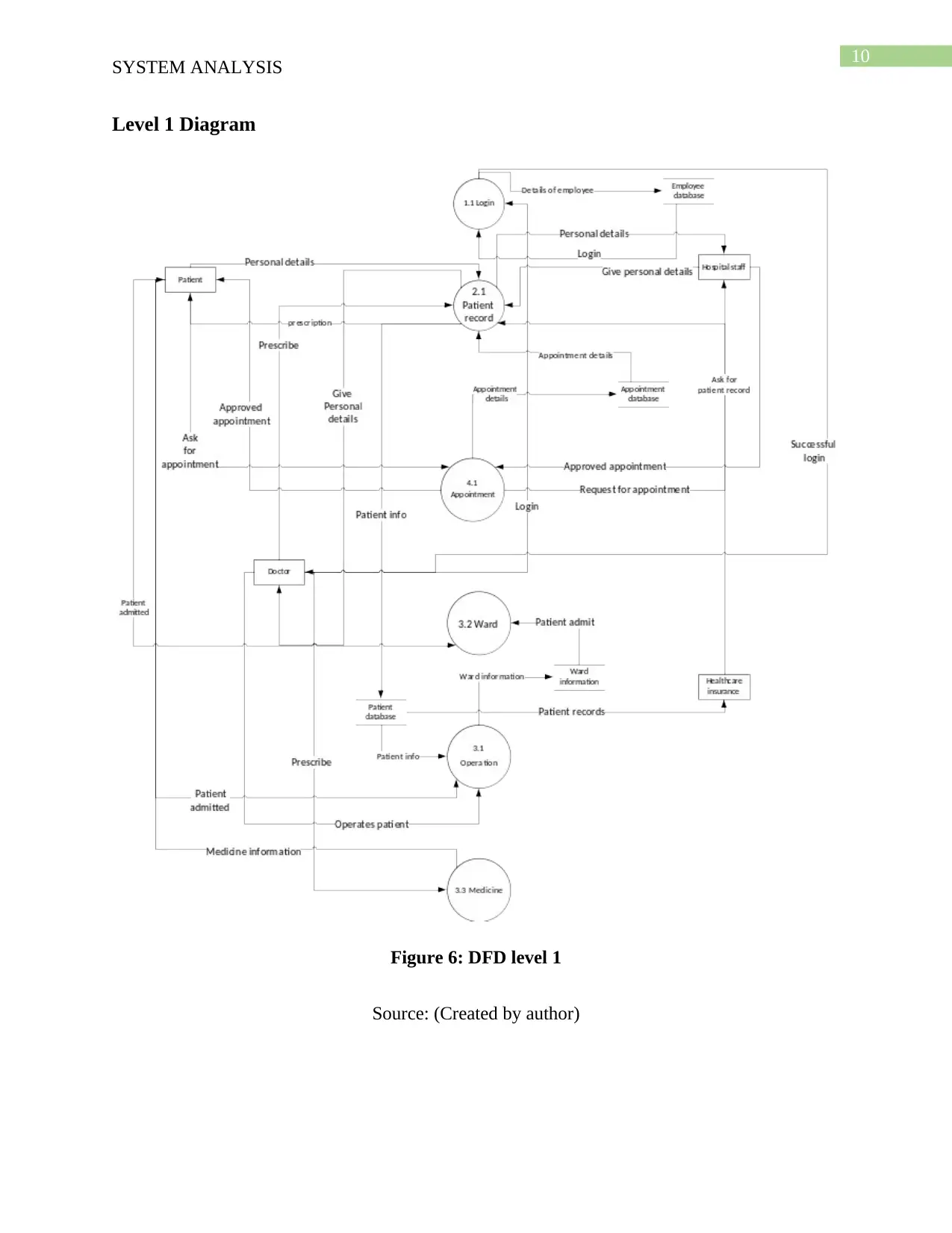
10
SYSTEM ANALYSIS
Level 1 Diagram
Figure 6: DFD level 1
Source: (Created by author)
SYSTEM ANALYSIS
Level 1 Diagram
Figure 6: DFD level 1
Source: (Created by author)
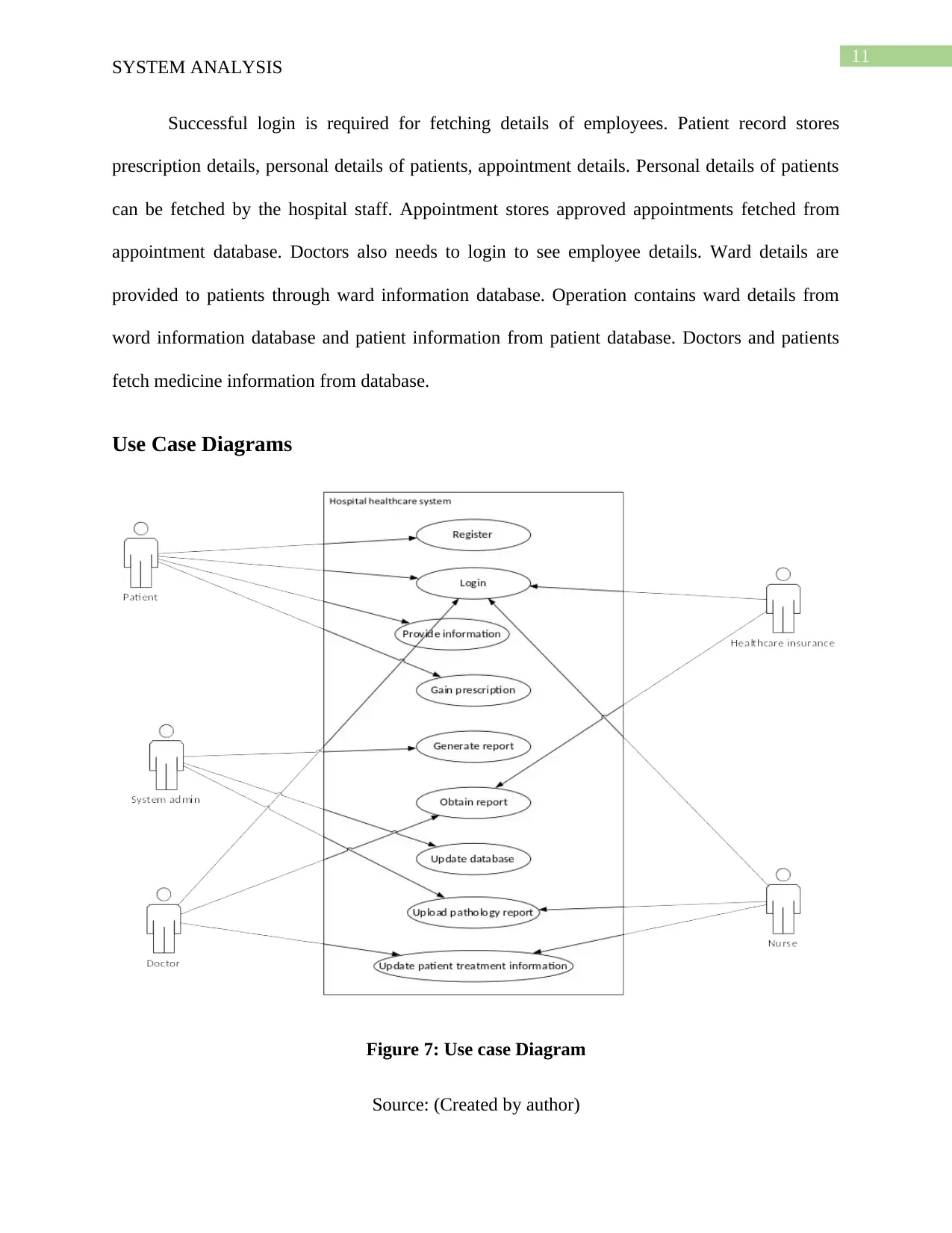
11
SYSTEM ANALYSIS
Successful login is required for fetching details of employees. Patient record stores
prescription details, personal details of patients, appointment details. Personal details of patients
can be fetched by the hospital staff. Appointment stores approved appointments fetched from
appointment database. Doctors also needs to login to see employee details. Ward details are
provided to patients through ward information database. Operation contains ward details from
word information database and patient information from patient database. Doctors and patients
fetch medicine information from database.
Use Case Diagrams
Figure 7: Use case Diagram
Source: (Created by author)
SYSTEM ANALYSIS
Successful login is required for fetching details of employees. Patient record stores
prescription details, personal details of patients, appointment details. Personal details of patients
can be fetched by the hospital staff. Appointment stores approved appointments fetched from
appointment database. Doctors also needs to login to see employee details. Ward details are
provided to patients through ward information database. Operation contains ward details from
word information database and patient information from patient database. Doctors and patients
fetch medicine information from database.
Use Case Diagrams
Figure 7: Use case Diagram
Source: (Created by author)
⊘ This is a preview!⊘
Do you want full access?
Subscribe today to unlock all pages.

Trusted by 1+ million students worldwide
1 out of 15
Related Documents
Your All-in-One AI-Powered Toolkit for Academic Success.
+13062052269
info@desklib.com
Available 24*7 on WhatsApp / Email
![[object Object]](/_next/static/media/star-bottom.7253800d.svg)
Unlock your academic potential
Copyright © 2020–2025 A2Z Services. All Rights Reserved. Developed and managed by ZUCOL.





